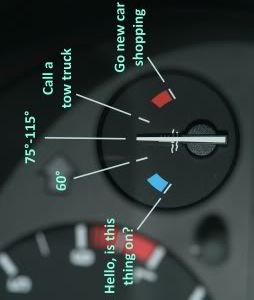Temp gauges in most cars currently sold don't actually show you how hot the coolant really is, anyway. They only show you a "range" of temperatures depending on the programming in the ECU.
If you watch them carefully, you will see that once the car is up to temperature, they stay perfectly still, showing the same temp as if you just got up to operating temp, or your cooling fans keep cycling on and off while in bumper to bumper traffic.
The reason why these gauges don't do anything is because when you have a vehicle where the gauge fluctuates with temperature changes, you then get a deluge of customer complaints about their car running hotter than normal, yet the gauge is still perfectly in the normal range.
I see those questions on motorcycle forums all the time.
So, you either make the gauge "dumb", and cause the 1% of the driving population who actually wants real information to be unhappy, or you make the gauge give real info all the time, and cause the 99% of the regular drivers to call in with complaints all the time, trying to get their car fixed under warranty for a normal behavior.
Honestly, I agree with the car manufacturers with completely removing the gauge on cars not going to be owned by driving enthusiasts. Really, a typical Subaru Owner isn't going to care about coolant temp fluctuations in 99% of owners.
BC.
If you watch them carefully, you will see that once the car is up to temperature, they stay perfectly still, showing the same temp as if you just got up to operating temp, or your cooling fans keep cycling on and off while in bumper to bumper traffic.
The reason why these gauges don't do anything is because when you have a vehicle where the gauge fluctuates with temperature changes, you then get a deluge of customer complaints about their car running hotter than normal, yet the gauge is still perfectly in the normal range.
I see those questions on motorcycle forums all the time.
So, you either make the gauge "dumb", and cause the 1% of the driving population who actually wants real information to be unhappy, or you make the gauge give real info all the time, and cause the 99% of the regular drivers to call in with complaints all the time, trying to get their car fixed under warranty for a normal behavior.
Honestly, I agree with the car manufacturers with completely removing the gauge on cars not going to be owned by driving enthusiasts. Really, a typical Subaru Owner isn't going to care about coolant temp fluctuations in 99% of owners.
BC.


